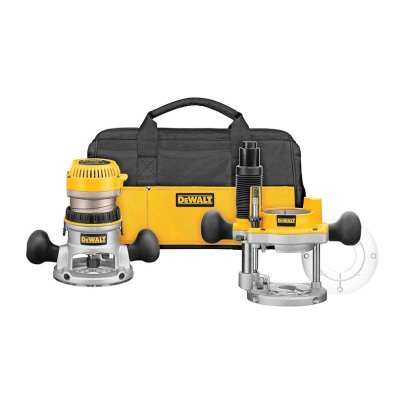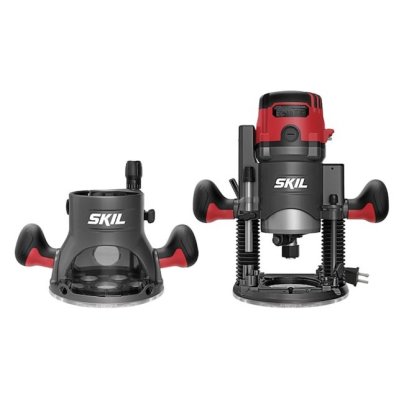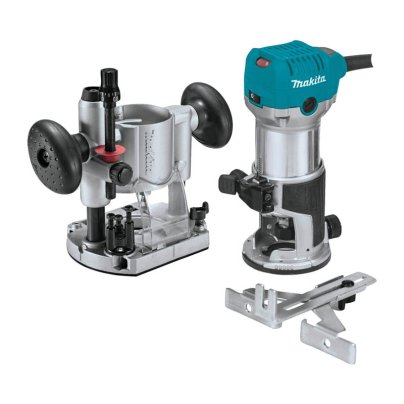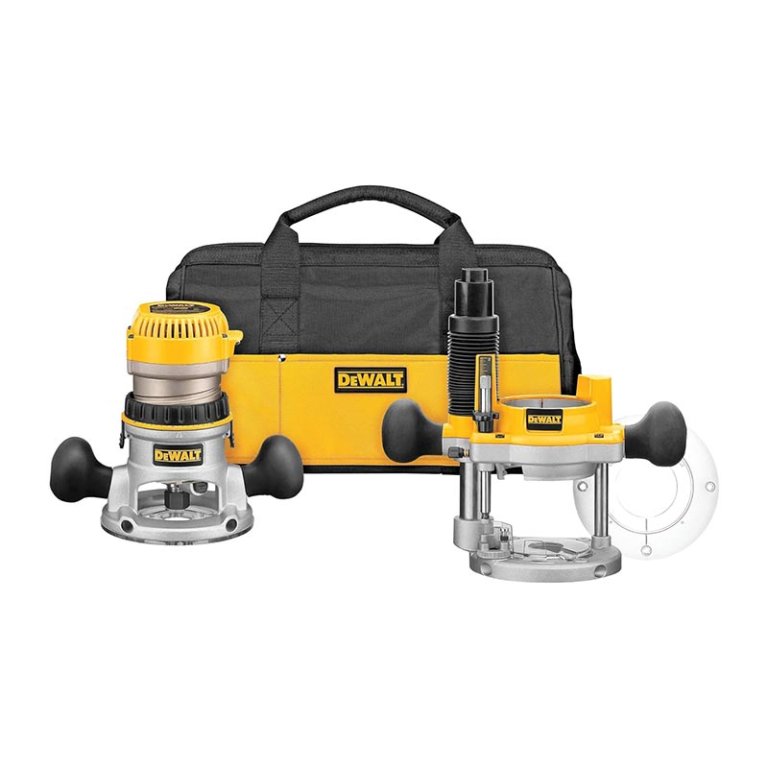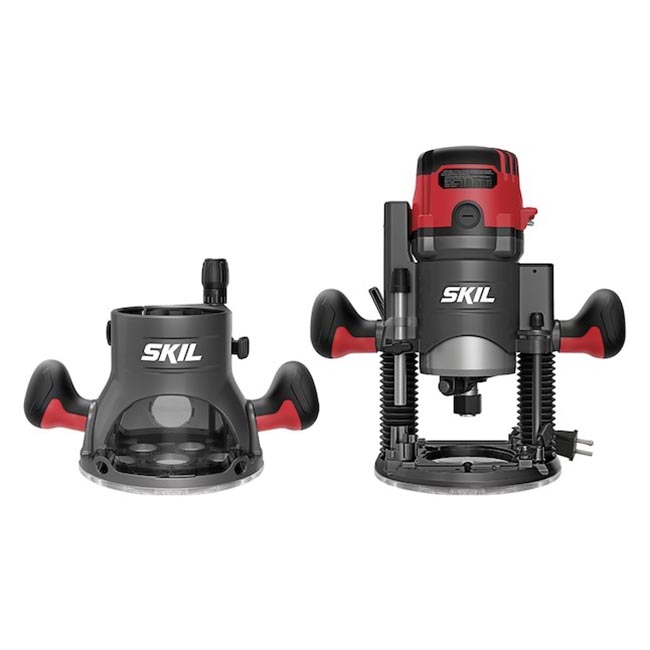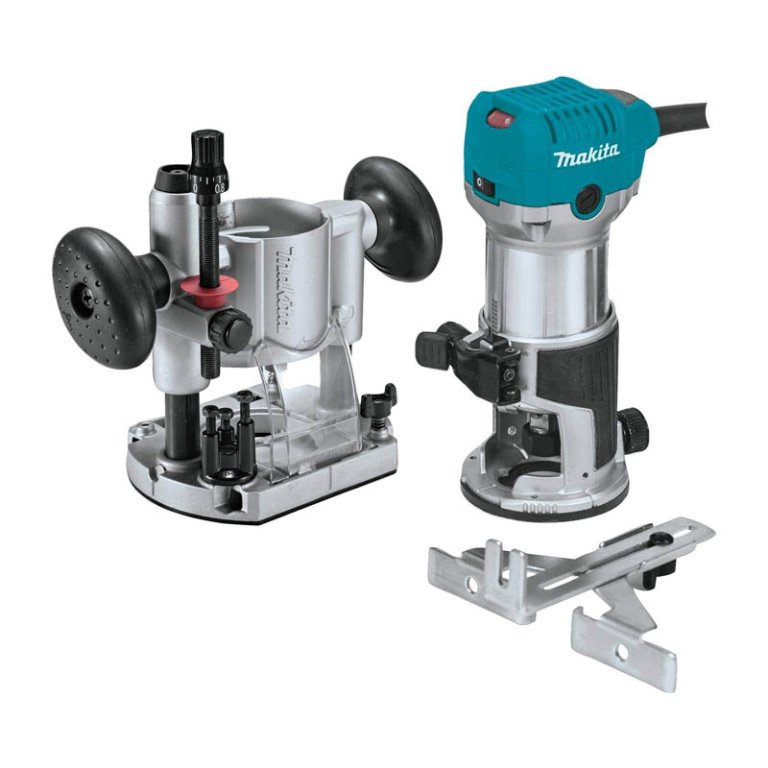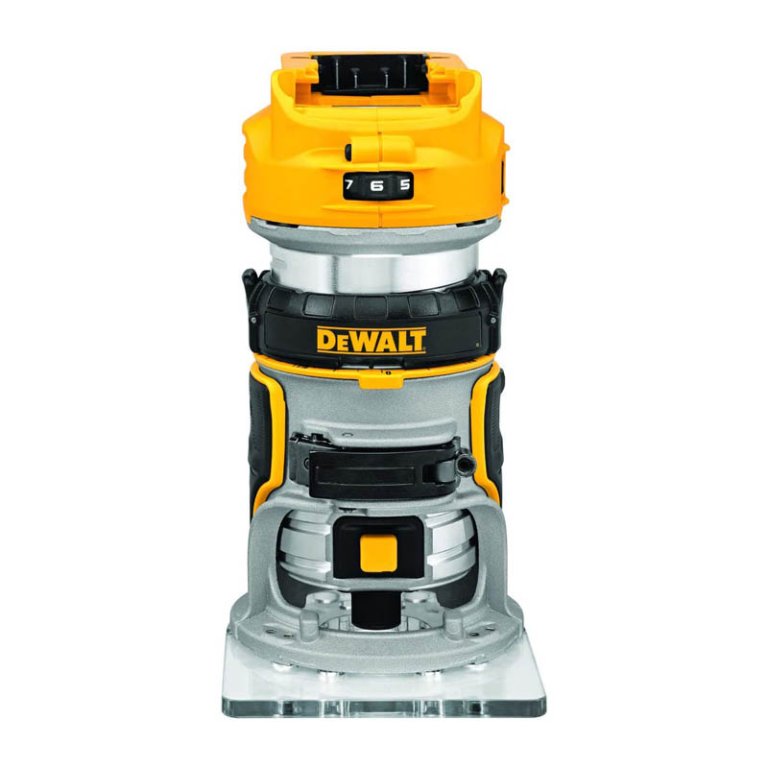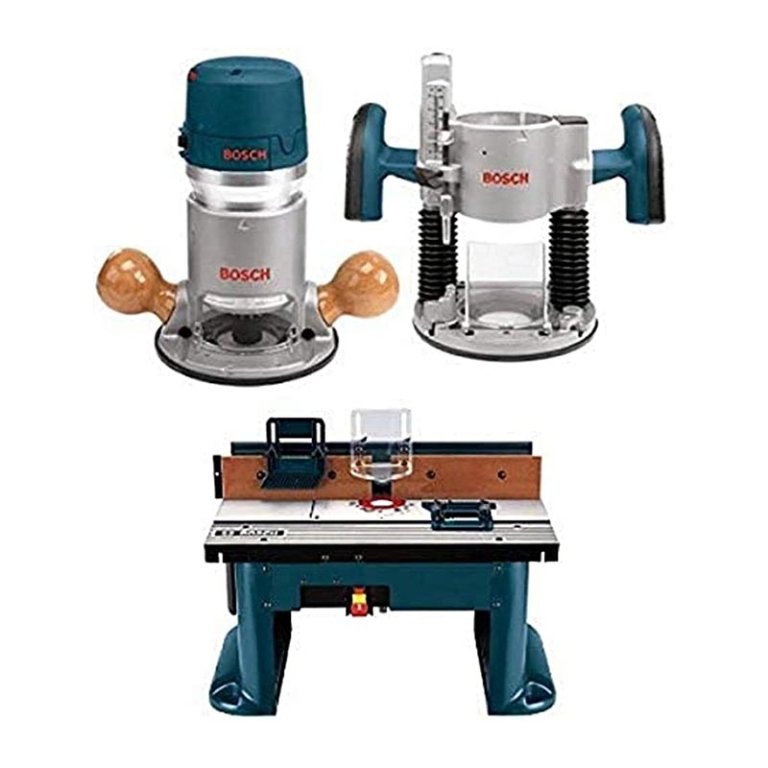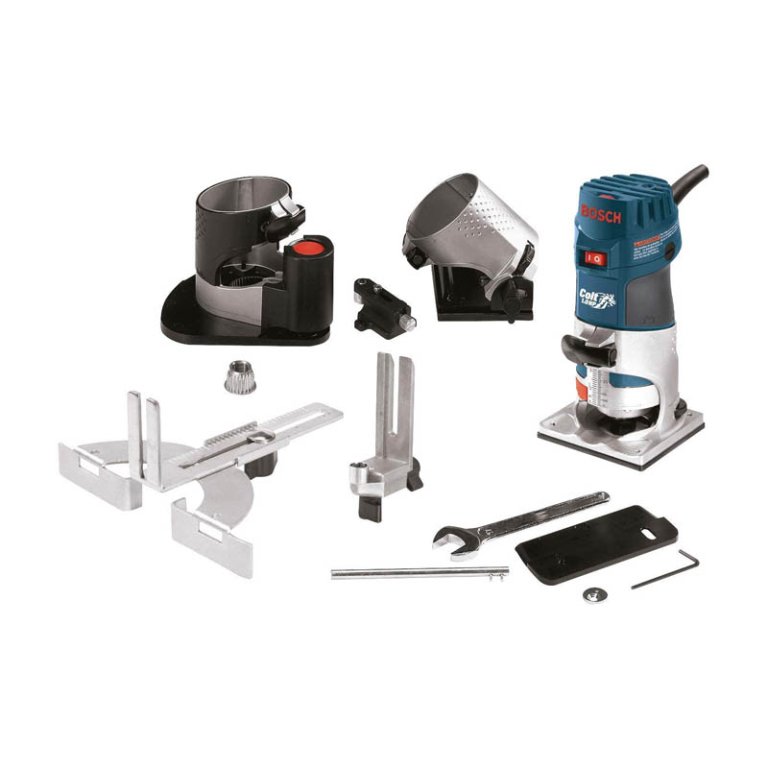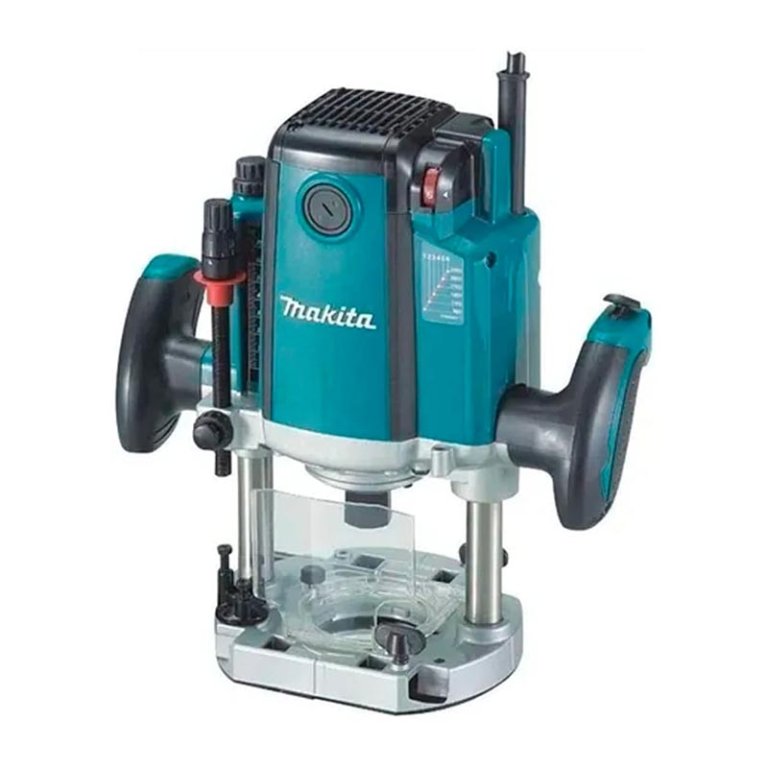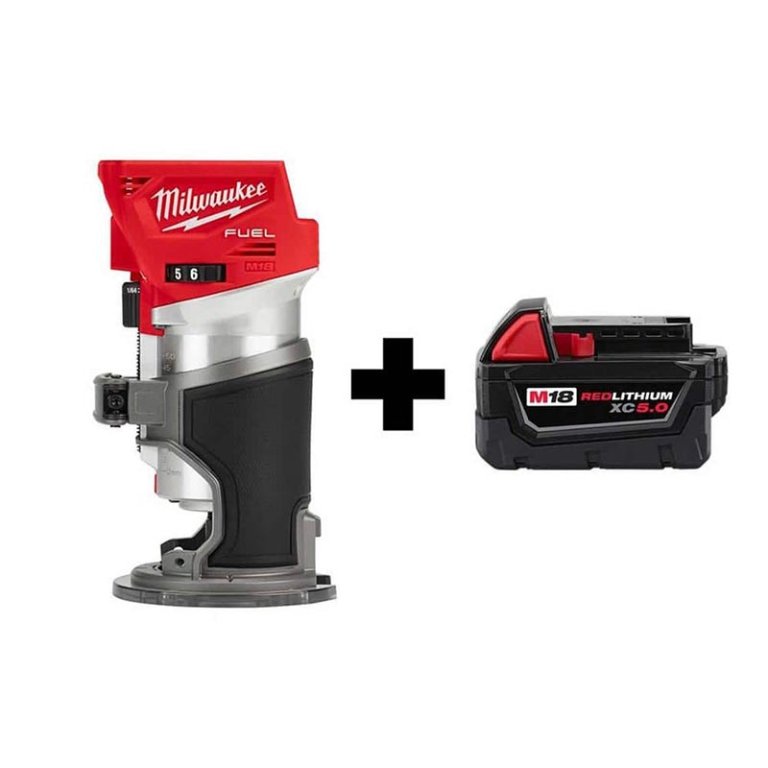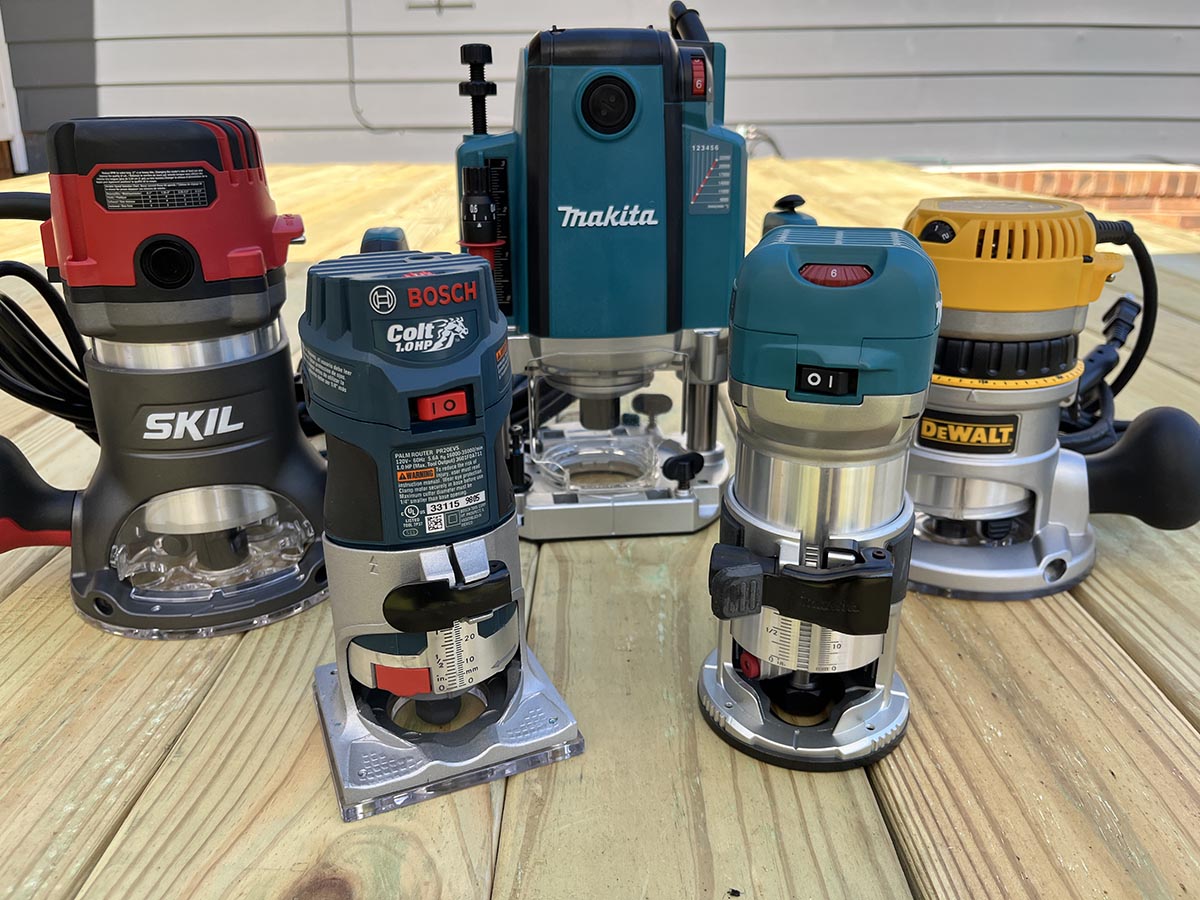
We may earn revenue from the products available on this page and participate in affiliate programs. Learn More ›
Whether you’re building your first piece of furniture or crafting custom cabinetry, wood routers make it easy to create sharp edges, cut decorative details, and install joinery across all kinds of workpieces. But with options ranging from 1 to 3 horsepower (hp), corded and cordless models, plunge and fixed bases, ¼ inch and ½ inch bits, and more, it’s important to match the tool to the planned work. In our search for the top tools, we tested 8 wood routers of all types and sizes, with an eye toward ease of use and consistent results. After nearly 20 hours of testing and 120 linear feet of router cutting in our workshop, we’ve made up our minds and identified the best wood routers for new users.
For those who are new to router tools, choosing the right model can prove something of a challenge. Our top spot goes to the DeWalt EVS Fixed and Plunge Base Router Combo thanks to its strong motor, user-friendliness, and versatility. But many projects call for heavier-duty or more lightweight options. The following guide provides comprehensive information to aid beginner woodworkers in their decision-making when selecting the best wood router for their projects. Read on for our tested product reviews and expert tips on choosing the best wood routers for beginners.
- BEST OVERALL: DeWalt EVS Fixed Base/Plunge Router Combo Kit
↓ Jump to Review - BEST BANG FOR THE BUCK: Skil 14-Amp Plunge and Fixed Base Corded Router
↓ Jump to Review - BEST PALM: Makita RT0701CX7 1¼ HP Compact Router Kit
↓ Jump to Review - BEST CORDLESS: DeWalt 20V MAX XR Brushless Cordless Compact Router
↓ Jump to Review - BEST ROUTER TABLE COMBO: Bosch 1617EVSPK Professional Combo Pack Routers
↓ Jump to Review - BEST KIT: Bosch 1 HP Colt Router Installer’s Kit
↓ Jump to Review - BEST CORDED: Makita 3¼ HP Plunge Router With Variable Speed
↓ Jump to Review - BEST COMPACT: Milwaukee M18 Fuel Compact Router
↓ Jump to Review
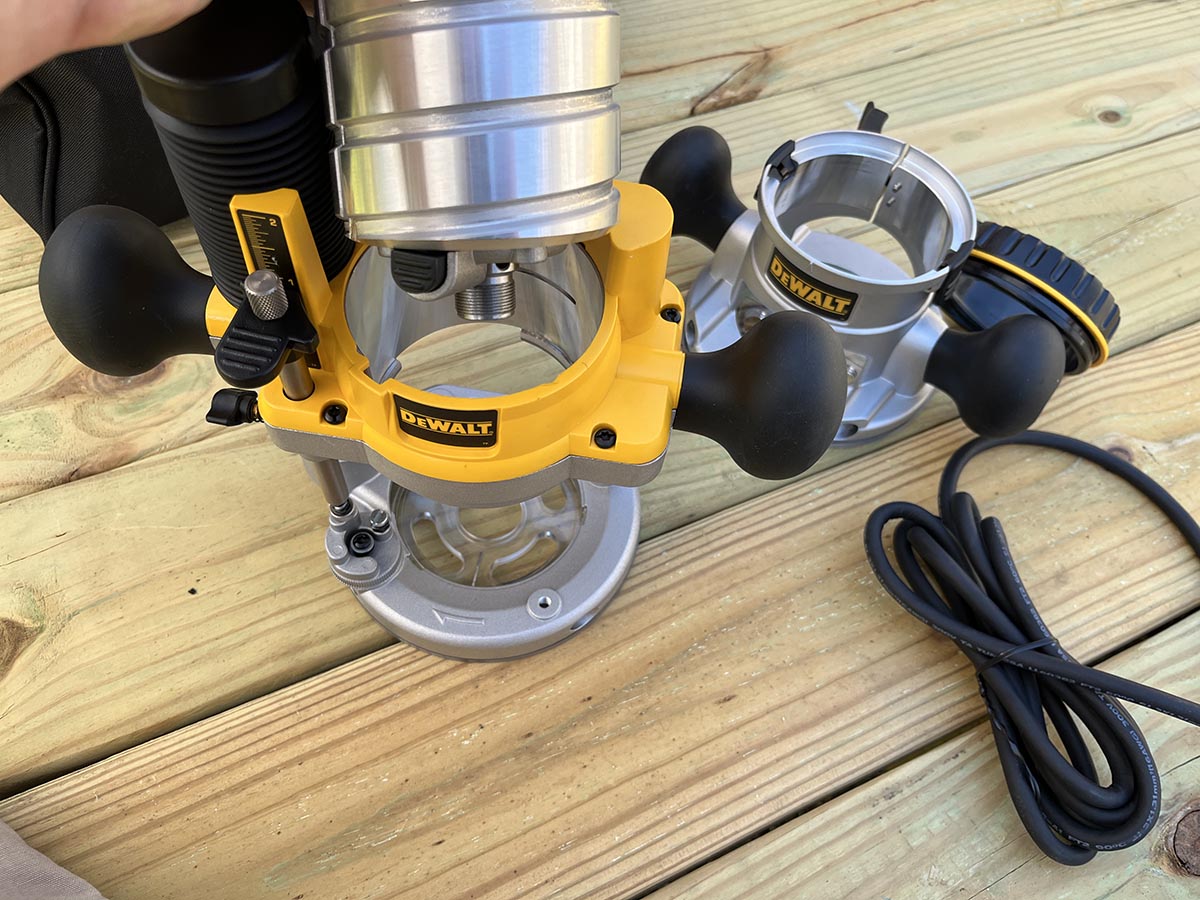
Our Top Picks
We tested the following wood routers over the course of three days, with a sequence of edge profiling, dado cutting, and pattern cutting. The following selections include individual categories based on considerations such as type, features, or budget.
Best Overall
DeWalt EVS Fixed Base/Plunge Router Combo Kit
What We Like
- Fast, easy height adjustments and base changes
- Convenient through-the-column dust collection system
- Powerful router with soft start and electronic feedback
- Plunge and fixed bases for a variety of applications
- Accepts ¼-inch and ½-inch router bits
What We Don’t Like
- Not as easy to adjust in a router table
Specs
- Type: Plunge and fixed
- Horsepower: 2 ¼ hp
- Collet size: ½ inch and ¼ inch
Our Ratings: Ease of Use 5/5; Build Quality 5/5; Performance 5/5; Value 5/5
The DeWalt wood router combo with a fixed and plunge base is a professional-grade tool that also works well for the enthusiastic beginner. Though it requires a larger investment than some beginner routers, this is a high-quality, versatile tool that should last a lifetime.
The model comes with both ½-inch and ¼-inch collets. Both quick-change fixed and plunge bases are included with the router to tackle just about any routing task. The 2 ¼ hp motor incorporates soft start and constant speed balancing, varying from 8,000 to 24,000 revolutions per minute (RPM).
Additional features that may be helpful to beginners and more experienced woodworkers include a micro-fine adjustment for depth setting and particularly efficient dust collection so the router bit remains easily visible while working. The router also comes with a hard-wearing tool bag.
In our tests, the DeWalt EVS router combo proved to be a great option for beginners. It made quick work of edge profiles and dado cuts with good precision and clean edges. And it moved smoothly, without chatter or bogging down in dense hardwood, knots, or cutting deeper grooves. The spindle lock accommodated (normally) quick bit changes, although sometimes we had to wrestle an extra-snug bit from the collet. The only place we really struggled with adjustments was in the router table. It would work best with a router lift, because the fixed base does not include a height adjustment screw through the base plate.
What our tester says: “If I was shopping for my first router, I would want a tool like this. The DeWalt EVS router combo made routing by hand easy. It was easy to operate and just heavy enough for good balance, but not too heavy for occasional trim work. It’s not the cheapest option, but you may never need to replace it.” —Mark Wolfe, product tester and writer
Get the DeWalt combo wood router for beginners at Amazon, The Home Depot, or Acme Tools.
Best Bang for the Buck
Skil 14-Amp Plunge and Fixed Base Corded Router
What We Like
- Outstanding value for a midsize router
- Easy-to-read LCD speed and material settings display
- Live tool indicator for safety
- Compatible with most router tables
What We Don’t Like
- The ¼-inch collet was difficult to tighten
Specs
- Type: Plunge and fixed
- Horsepower: 2 ½ hp
- Collet size: ¼ inch and ½ inch
Our Ratings: Ease of Use 4.7/5; Build Quality 4.5/5; Performance 5/5; Value 5/5
After running the Skil RT1322 through our testing gauntlet, we were thrilled to have found a highly capable tool for such a modest price. With power, performance, and accessories rivaling some of the best rated wood routers, this 14-amp fixed/plunge base router combo costs about $100 less than our top pick. Experts will note minor flaws when compared to the absolute precision of some higher-priced options, but it could be an excellent option for beginners on a budget.
In addition to the two bases, this kit includes ¼-inch and ½-inch collets, a collet wrench, straight guide, and dust port. It features a spindle lock to facilitate quick bit changes, but we experienced some difficulty tightening and loosening ¼-inch bits. We installed and changed ½-inch bits without much effort, but we had to brace the motor on the workbench while pressing the spindle lock button in order to fully tighten or loosen the thinner bit shafts.
One feature that stood out on this router was its digital RPM display with six pre-programmed speed settings. A reference chart posted on the motor housing helps users choose the appropriate speed setting based on bit diameter and material hardness. During operation, the router’s electronic feedback system automatically increases or decreases power output to maintain consistent RPM as the bit travels through the workpiece.
We also noted that the Skil router includes a depth adjustment screw on the underside of the fixed base for use with a router table. It worked flawlessly in ours. It was easy to adjust the bit height while the router was mounted on the table, and we figured out how to change bits without removing the router, but we had to lift the router from the table to adjust the bit speed.
Get the Skil wood router for beginners at Amazon or Lowe’s.
Best Palm
Makita RT0701CX7 1¼ HP Compact Router Kit
What We Like
- Compact and lightweight but powerful
- Includes plunge and fixed bases
- Easy one-handed control
- Adjustable bit speed, up to 30,000 RPM
What We Don’t Like
- Power cord restricts range of motion in some applications
Specs
- Type: Plunge and fixed
- Horsepower: 1 ¼ hp
- Collet size: ¼ inch
Our Ratings: Ease of Use 5/5; Build Quality 5/5; Performance 5/5; Value 4.7/5
Makita’s RT0701CX7 compact router offers a comprehensive kit that fulfills the needs of many new router users. For their investment, they get an accurate tool that can last for years. This ¼-inch router with a 1 ¼ hp motor delivers enough power for many workshop and DIY tasks without being difficult to manage. It’s small enough to be portable, weighs under 4 pounds, and comes with both fixed and plunge bases.
The router features variable-speed control between 10,000 and 30,000 RPM, backed up by electronic control that keeps the speed constant while under load. Cam locks rapidly adjust the initial cutting depth. A three-position turret helps with preset depths, plus features rack-and-pinion fine adjustment to ensure precision. For those new to wood routers, this is a superb package at a great price.
With the fixed base installed, we were able to comfortably control the lightweight Makita router with one hand. The thick motor housing and textured grip on the base eliminated virtually all vibration, and the high-end RPM ensured clean edges. This was an extremely comfortable grip for cutting edge profiles. With the plunge base installed, we were able to follow pattern templates to cut complex shapes out of thin plywood and laminate as well as carve decorative grooves into deeper wood pieces. For small-scale woodworking projects or detail work on larger pieces, this router is one of the best.
Get the Makita 1¼ hp wood router for beginners at The Home Depot, Rockler, or ToolNut.
Best Cordless
DeWalt 20V MAX XR Brushless Cordless Compact Router
What We Like
- Soft-start technology for gradual speed increase
- Compact enough for one-handed operation
- High RPM makes quick work of routing hardwood or softwood
- Easy-to-reach variable-speed dial
- Dual LED lights help to illuminate the work area
What We Don’t Like
- Best suited to small projects and detailed trim work
Specs
- Type: Fixed
- Horsepower: 1 ¼ hp
- Collet size: ¼ inch
Our Ratings: Ease of Use 5/5; Build Quality 5/5; Performance 5/5; Value 4.7/5
Power cords often can be frustrating, particularly with small, lightweight routers. DeWalt’s portable router works by rechargeable battery, giving it excellent maneuverability. The ¼-inch router has a soft-start motor rated at a competitive 1 ¼ hp, so there’s no performance penalty for choosing a battery-powered model.
This DeWalt trim router offers variable speed between 16,000 and 25,500 RPM and an electronic brake that brings it to a stop quickly. A clever height adjustment ring helps users quickly and easily set depths. An extended base improves stability, and two LED work lights provide excellent cutter visibility.
Like many cordless wood routers, the DeWalt comes as a “bare tool,” so for the total purchase price, factor in the cost of a battery and charger. However, owners of other DeWalt cordless tools might already have compatible batteries.
In testing, the DeWalt cordless router surprised us with an ample supply of power, precision, and versatility. It delivered on all of the points we expected from a professional-quality palm router with the added benefit of cordless mobility. The fixed base worked well in both hands or single-handed, as the task demanded. The placement of the speed dial allowed us to make adjustments with a thumb without shifting our grip on the tool.
As for cutting action, this type of router is typically used for edge work, but the clear base and onboard LED work lights gave ample visibility for some modified plunge work as well. This allowed us to mark an entry point and tip the bit into the precise spot on the workpiece in order to follow a pattern. This, along with a precision depth adjustment system, makes the DeWalt cordless palm router a versatile tool for both beginners and seasoned woodworkers.
Get the DeWalt compact wood router for beginners at Amazon, Lowe’s, or The Home Depot.
Best Router Table Combo
Bosch 1617EVSPK Professional Combo Pack Routers
What We Like
- Plunge base, fixed base, and benchtop functionality
- Powerful 12-amp motor automatically balances bit speed
- Router table has adjustable fence for accuracy and consistency
What We Don’t Like
- Requires access to electrical outlet for use
- Router table assembly is time consuming
Specs
- Type: Plunge and fixed
- Horsepower: 2 ¼ hp
- Collet size: ¼ inch, ⅜ inch, ½ inch, 8 mm
Our Ratings: Ease of Use 4.7/5; Build Quality 5/5; Performance 5/5; Value 5/5
For exploring the woodworking hobby or profession, this package of Bosch wood routing tools offers high performance with almost endless flexibility. The kit includes a plunge base, a fixed base, and a benchtop router table to get the maximum usage from the included router. The router features a 12-amp motor with speed adjustments up to 25,000 RPM, and accommodates both ½-inch and ¼-inch collets.
Changing from the fixed base to the plunge base was straightforward. It took about three minutes to swap bases, and both bases feature precision bit-depth adjustments. We tested the plunge base on pattern work and found it easy to align the bit and lower the router effortlessly for accurate cuts.
With the fixed base installed, we used the Bosch router to make freehand edge cuts and table cuts. It worked perfectly in both cases—the routed cuts were smooth and precise. The table is well-designed and sturdy, but it took about 30 minutes to assemble. Once assembled, however, it took only a few minutes to install and level the router in the table. The electronic feedback feature directed more power to the bit when we switched from pine to oak in order to maintain constant RPM. We heard the motor increase output to keep the bit spinning at our selected speed.
This kit is more expensive than many of the others we tested, but it’s a space-saving option for woodworkers who take on many different projects and need the full range of routing options.
Get the BOSCH 1617EVSPK wood router for beginners at Amazon, The Home Depot, or Acme Tools.
Best Kit
Bosch 1 HP Colt Router Installer’s Kit
What We Like
- Compact router for cutting small workpieces
- Multiple specialty bases for molding and trim
- High RPM for clean cuts in composite materials
- Great option for cabinetry, countertops, and furniture
What We Don’t Like
- Limited power for light-duty work
Specs
- Type: Fixed
- Horsepower: 1 hp
- Collet size: ¼ inch
Our Ratings: Ease of Use 5/5; Build Quality 5/5; Performance 5/5; Value 4.7/5
Palm routers like the Bosch Colt router tool are the smallest of the wood routers, often favored for light-duty jobs like laminate trim and edge molding. They are great for beginner cabinet makers who want to add simple design details that lift work out of the ordinary. Their compact size and portability can also make them a valuable addition to the DIY tool kit.
This is a ¼-inch router with an extended fixed base that offers good stability while the depth adjustment provides ease of use. The 1 hp motor has enough power for its intended purpose while offering easy one-handed operation. Speed varies from 16,000 to 35,000 RPM, and faster speeds work best for cutting composite materials.
The Bosch Colt was easy and comfortable to operate in one hand or two. It only took a few seconds to switch between different bases. To change bits, we had the option of using the spindle lock button or two wrenches, as best fit the circumstances. The included fixed and tilt bases include square baseplates that work particularly well with the straight edge and roller guides. The square baseplate also made it easier to maintain the router’s orientation when working with a jig. The unique offset base was especially useful when we needed to make cuts adjacent to inside corners.
What our tester says: “I really like the compact size and variety of bases that come with this kit. It’s more of a specialty set, but an ideal tool for precision edging and trim details on furniture and cabinetry.” —Mark Wolfe, product tester and writer
Get the Bosch 1 hp wood router for beginners at Amazon or Acme Tools.
Best Corded
Makita 3¼ HP Plunge Router With Variable Speed
What We Like
- Versatile plunge router can do it all
- Power for heavy-duty routing projects
- Locking on/off trigger on the handle
- Smooth ball bearing plunge mechanism
What We Don’t Like
- Large, heavy router is less suitable for small tasks
Specs
- Type: Plunge
- Horsepower: 3 ¼ hp
- Collet size: ½ inch
Our Ratings: Ease of Use 4.7/5; Build Quality 5/5; Performance 5/5; Value 4.7/5
Beginners might think their first router needs to be light- or medium-duty. That’s not always true, as some beginning woodworkers might want to undertake heavy-duty tasks. In that case, they need high performance with good control, which they can get from this heavy-duty Makita plunge router.
This ½-inch wood router machine has an immensely powerful 3 ¼ hp motor. While that enables large, aggressive cuts, the Makita remains relatively easy to handle, thanks to a smooth plunge action and big ergonomic handles that provide excellent grip.
The variable-speed control runs from 9,000 to a maximum speed of 22,000 RPM, and its soft start reduces torque reaction. Once underway, a lock-on trigger allows for continuous operation, which is very useful on long workpieces. An electric brake brings things to a fast stop. It’s a tool with impressive capabilities, but it’s also a very manageable one.
The Makita RP2301FC plunge router proved to be a heavy-duty contender among our tested routers. What makes it so compelling is an excellent combination of power and finesse. Rather than simply using it for edge profiles like all of the others in the test group, we installed a 2-inch diameter surfacing bit and used it to flatten a rough board. The power was incredible but the most impressive thing was its smooth, controllable operation. The depth was easy to adjust with a high degree of accuracy, and the weight of the motor helped us make clean, smooth passes, cutting up to ¼ inch deep.
Get the Makita 3¼ hp wood router for beginners at Amazon, The Home Depot, or Rockler.
Best Compact
Milwaukee M18 Fuel Compact Router
What We Like
- High RPM makes for smooth routed edges
- Compact enough for one-handed use
- Precise depth adjustment
What We Don’t Like
- Inefficient dust collection, even when attached to vacuum
- Does not include battery charger
Specs
- Type: Fixed
- Horsepower: 1 ¼ hp
- Collet size: ¼ inch
Our Ratings: Ease of Use 5/5; Build Quality 5/5; Performance 5/5; Value 4.7/5
The Milwaukee cordless palm router offers endless freedom of movement thanks to its compact size and cordless operation. It is available with a rechargeable M18 lithium-ion battery (but no battery charger), or as a bare tool. For current Milwaukee M18 tool owners this won’t be an issue because the batteries and chargers are interchangeable, but anyone who doesn’t have a charger will need to buy one separately.
We tested this fixed-base router on both board edges and on board faces. Since it is a fixed-base model, we had to tip it to start middle cuts. The open base design and the see-through acrylic ring at the outer edge of the base offered extra visibility, as did the bright LED work light. The results were good.
The depth adjustment was precise and easy to change, but the dust collection port was not great. To assemble it, we had to disassemble the base and reassemble it with the port in place. When we hooked it to our workshop vacuum, we didn’t notice an appreciable reduction in router dust. Most of the dust still came out of the bottom of the tool.
This compact Milwaukee router is best suited to trim work and other light-duty projects. It only works with ¼-inch shaft router bits. The RPM adjusts up to 31,000 by means of a speed adjustment dial, making for smooth edges that require minimal sanding.
Get the Milwaukee wood router at The Home Depot, Ace Hardware (tool only), Northern Tool & Equipment (tool only, or Walmart.
Jump to Our Top Picks
How We Tested the Best Wood Routers for Beginners
| Testing Stats | |
|---|---|
| Products tested | 8 |
| Time spent testing | 20 hours |
| Tests performed | 5 |
| Price range | $100 to $360 |
To make sure we sourced only the best wood routers for beginners, we consulted Jonathan Warshaw, a professional woodworker with over 15 years of experience and the founder and owner of educational woodworking site SimpleWoodworker. Warshaw encourages shoppers to look for a few key features when searching for a wood router for beginners, including “a fixed and plunge base … as it provides versatility for different routing tasks” as well as “a variable speed setting for better control and adaptability, catering to different woodworking requirements.” Finally, Warshaw highly recommends that shoppers consider a good dust collection system “to maintain a clean and safe working environment, as it effectively manages wood shavings and dust produced.”
We selected plunge and fixed-base routers that run from 1 to 3 ¼ horsepower to accommodate multiple project types. We were also careful to pick options that varied in construction and design, and were safe and easy to use. As Warshaw suggests, “utilizing a router table for smaller pieces provides a stable platform, ensuring precise cuts and reducing the risk of accidents. On the other hand, a handheld router is better suited for managing larger pieces, offering flexibility in movement and access.”
To test the routers that we selected, we made decorative edge cuts, grooves, and dado cuts. We also tested the larger models for slab flattening. We spent at least two hours with each model, changing router bits and working with different types of wood. Afterwards we recorded our observations with regard to power, performance, and ease of use, and scored them on a rubric before awarding titles.
What to Consider When Choosing a Wood Router for Beginners
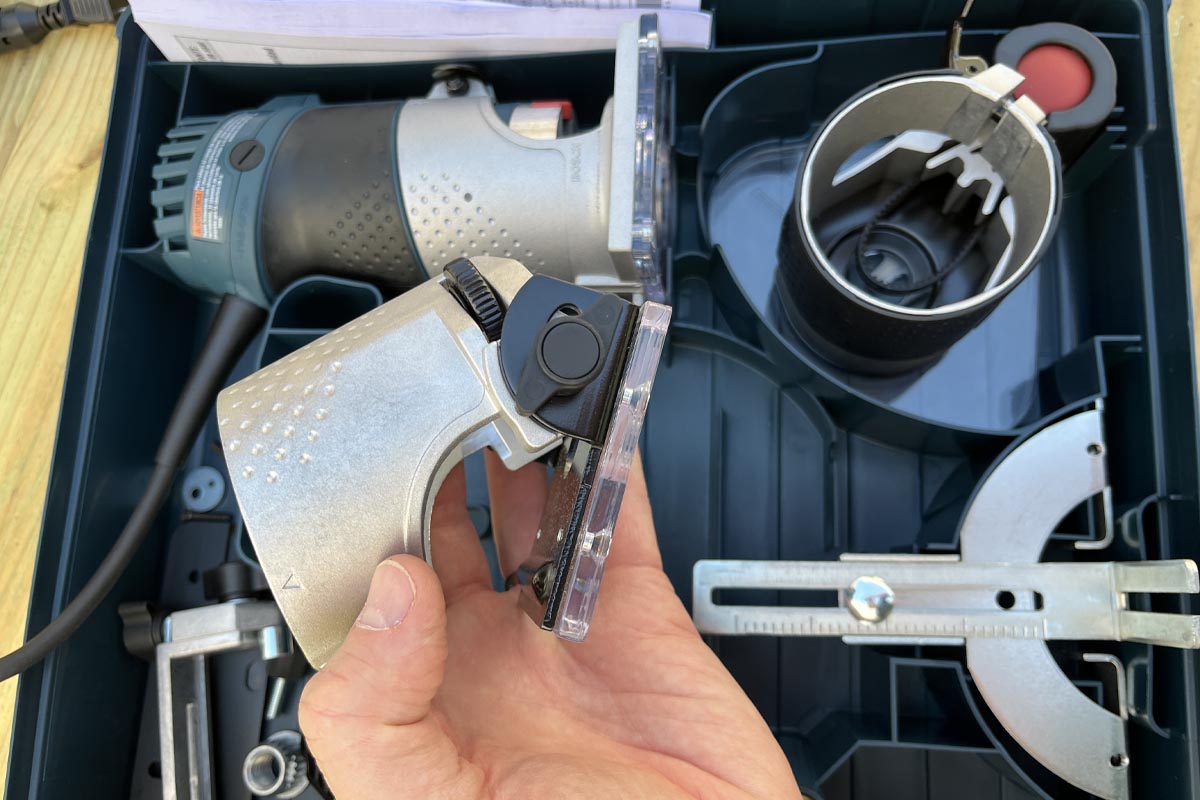
While they all offer versatility, a few key features separate some types of wood routers from others. For instance, the best general-purpose wood router for a DIY enthusiast will look different than a router designed for the woodworker specifically making small decorative items. The following section looks at these features in detail and can help beginners understand the options available.
Type
Wood routers can be divided into two main types: fixed base and plunge base.
- With a fixed-base router, the cutter stays in place during the cut. Any depth adjustment happens before the work starts. This is useful when the woodworker needs to reproduce the same cut numerous times. With its ease of setting and precision, fixed-base routers generally rank first for use with a router table. The fixed base is also somewhat simpler than plunge mechanisms, so these models often cost less.
- With a plunge-base router, springs hold the cutter away from the workpiece until the user applies downward force. However, they can lock in the down position if required. With plunge action, the cut doesn’t have to start at the edge of the material, allowing for the cutting of grooves and slots.
The other main difference between plunge and fixed routers is physical size. Many wood routers, especially plunge routers, have twin handles to provide stable control whereas “palm” routers are smaller and only require one hand to hold the main body of the tool. The latter are usually fixed base, though a plunge adapter might be available as an accessory.
Projects
The right wood router for a beginner can greatly depend on the type of projects they have planned. These handy tools can cut decorative moldings on door frames, mortise and tenon joints for fine furniture, fit hinges to small jewelry boxes, and plenty more.
A wood router needs stability to cut accurately. If the base rocks around, so will cuts. Guides can help a beginner maintain control, but a large router on a small workpiece isn’t ideal. Equally, a small router is unlikely to have the power for continuous heavy-duty work.
Most of the wood routers in the top picks section are midrange tools designed to offer great versatility in projects and work easily for beginners. It is nevertheless important to consider the type of tasks before choosing the best wood router. Enthusiastic woodworkers and professionals frequently end up with more than one router to cover all of their eventualities.
Collet Size
Wood routers are generally rated by their collet size, which is either ¼-inch or ½-inch diameter. This describes the shank diameter of the router cutter that can be used, which affects the type of work they can do.
A ¼-inch router is usually a light-duty model. Although there may be exceptions, router cutters with a ¼-inch shank are rarely more than ¾ inches across. This makes them unsuitable for large moldings and heavy-duty joints, for example. By contrast, a cutter with a ½-inch shank seldom has a cutting diameter less than that, so these tools suit medium to heavy-duty tasks.
Routers with ½-inch collets frequently also come with a ¼-inch collet to accommodate smaller cutters, though it’s worth checking since that’s not always the case.
Horsepower
The horsepower rating of a wood router is a good indication of its power. Horsepower relates closely to the amount of torque available, which is key to any tool that relies on rotary performance. That said, manufacturers rarely provide actual torque figures.
Even light-duty palm routers usually fall in the ¾- to 1-hp range. Most midrange models rank at 2 hp or higher and often present the ideal compromise for beginners. Tools with 3 hp can be defined as pro-grade models. They offer impressive power, but many require some skill to use to their full potential.
The challenge with horsepower ratings is that manufacturers can calculate it in different ways, so it isn’t a definitive figure for comparison purposes. It’s worth checking amps as well to get a fully informed view.
Variable Speed
Budget-friendly routers often have a fixed speed. With small- to medium-cutter sizes this is rarely a problem, because most often users will run them as fast as they’re able. However, this can be a problem with larger cutters. The speed at the cutting edge can be too fast to cut efficiently; the cutter will judder or scorch the wood instead. The solution is to turn down the speed.
Some large cutters come marked with a maximum recommended RPM. In these situations, a variable-speed router is a necessity.
The product description also might mention constant speed. This isn’t the same as fixed speed. A constant speed router has electronic circuitry that senses load and adjusts power accordingly (it’s also called load balancing). It will maintain the same performance level if, for example, the density of the wood changes.
Additional Features
A comfortable grip is essential for router control, particularly with larger routers that deliver high torque. Most offer two handles. Some models feature an on-off switch in the handle, which adds convenience.
Palm routers usually have a body that a user can grip with one hand, though beginning woodworkers with small hands might want to check physical dimensions. In this case, the user might find a small fixed or plunge router with two handles easier to use. Soft start is another useful feature that keeps the tool from jumping suddenly to life at full speed.
Depth adjustment varies considerably. Some routers control depth by a sliding lock, but a rack-and-pinion drive is better for maintaining accuracy. Those seeking maximum precision may want to check increments, too. Several wood routers have turrets that a user can set to commonly-used depths. Changing between them can be as quick as simply clicking them into place when needed.
Wood routers can create a lot of dust, so a dust collection port is a big help in keeping the cutter area visible and reducing workshop cleanups. Those who already have workshop extraction systems should check port size. They might need an adapter—an inexpensive and readily available purchase.
FAQs
With the main criteria in mind for finding the best wood router for beginner woodworkers, plus a list of top picks to choose from, you might be ready to select your new router. However, router woodworking is a complex subject, so it’s possible that a few questions remain. Here are answers to other common queries.
It’s important to think about the tasks you want to perform. A ¼-inch model often works best for beginner woodworkers because they are light and easy to maneuver. However, if you regularly need to make heavy cuts, a ½-inch router will be a better choice.
It depends on the capability of the router and the size of the bit. Generally, somewhere between 1 ½ and 2 ½ inches will suffice. However, many router cuts are done on the side of material or for molding purposes, so maximum depth is seldom the most important consideration.
Precise speed isn’t a key issue unless you have a large router cutter with a particular rating. Type is more important. Fixed-speed routers can cope with most jobs, but when using large cutters, a variable-speed model is invaluable. Another consideration is that a variable-speed router gives the beginner more versatility—and hence more opportunity to learn—than a fixed-speed model.
It’s not difficult to learn how to use a router, which adds to the tool’s popularity. The key issue is stability of the tool and workpiece. If you approach a loose piece of wood with a router cutter spinning at 20,000 RPM or more, the risk of an accident goes way up. Make sure the workpiece is clamped securely. Until you have gained some experience, work horizontally and keep a firm grip on the router with both hands. Get some practice with scrap pieces before tackling a “real” job.
Good wood routers range from a little over $100 to more than $400, depending mostly on the horsepower rating and the accessories included with the kit.
Routers are versatile tools that can complement or substitute for other tools in the workshop. Basic wood router techniques are easy to learn, but like anything else, proficiency takes time and practice.
Like other power tools, wood routers are loud, dusty, and are accompanied by safety concerns related to electricity and rapidly spinning bits.
Lightweight, compact wood routers (less than 2 hp) mostly accept only ¼-inch bits and are ideal for freehand work like creating decorative edges, flush cutting laminate, installing door hardware, and the like. Where versatility is required, midsize routers (2 to 2 3⁄4 hp) usually accept ¼-inch or ½-inch bits, often come with both fixed and plunge bases, and can tackle a wide range of small to large projects. Large wood routers (more than 2 ¾ hp) are the most powerful, most expensive, and often the best quality, but they are not ideal for frequent light duty projects.
Meet the Testers
Mark Wolfe is a writer and product tester with a background in the green industry. He’s also an avid DIYer who lives in an older home. When he isn’t writing, he spends his time upgrading, repairing, and replacing anything and everything in his home, yard, and garden. He tests and writes reviews about tools, lawn care and home repair products, and outdoor living goods.
Additional research provided by Bob Beacham.
